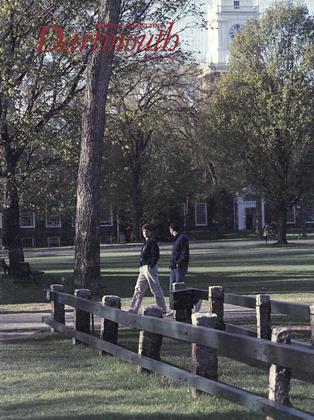A goodly number of Dartmouth men and women manage to get back to Hanover in the spring and early summer for class officers' meetings, reunions, graduation, lunch at the Inn, a walk around Occom Pond, whatever. My guess is it doesn't take much prodding for most of them to leave work a day or so early. One group of dedicated volunteers is our Editorial Board, which convenes twice a year, once around Green Key and then again before Dartmouth Night in November. I thought you might like to know about a couple of things I'll be discussing with them.
Item 1. Letters. In two years as Editor of your magazine, I've printed a total of 287 letters, 42 of which have dealt in one way or another with the Indian symbol. This may not seem like much, but it accounts for nearly 15 percent of the Letters to the Editor section. Recently, there's been a dramatic revival of Indian-letter-writing, with more than half of the letters in the previous two issues alone (12 out of 20 in March and 11 out of 19 in April) dealing with the symbol. The battle lines have been drawn for a long time in this seemingly endless guerilla war. There are many around the girdl'd earth and back in Hanover itself who feel that there are more important issues facing Dartmouth and private, liberal arts education in general than the Indian symbol. This is not to deny that there is an issue here and an important one for the College. There is. Yet knocking it about in the Magazine for more than a decade has done little more than stir up old animosities.
Item 2. Production. Charlie Widmayer '3O ended his warm remarks at the Magazine's 75th Anniversary Din- ner with the statement, "I hope I live long enough to see the Magazine come out on time." Everyone howled. Everyone except me, that is. One Southern gentleman, who happens to be on the Alumni Council, writes me letters every now and then reminding me how late we are. I'll tell you what I'm going to tell my Board (and my friend, too, when the Council convenes for its 150 th meeting later in May), we're working on it overtime. Over the past year we hired a new printer, mapped out new staff responsibilities, and edged the Magazine into the 20th century with IBM PCs that allow us to set our type in-house. Each of these steps has taken longer than we anticipated; some have generated new problems in themselves. But we have always felt our first charge is producing a magazine that is informative, accurate, and readable.
Item 3. Finances. Unlike alumni publications at most colleges and universities, your magazine is wholly supported by subscription fees that come from class dues (that's why, if you aren't paid up, your Class Treasurer is on your case) and by the advertising revenues we generate. Subscriptions, incidentally, account for a whopping two-thirds of our gross income. Magazines at some of our sister colleges get subventions in the hundreds of thousands of dollars. The Dartmouth Alumni Magazine by contrast, gets from the College what the other Ivy editors consider to be the handsomest office suite in the Ivy League, but not a penny from dear old Dartmouth. We're proud of that and feel that what Emerson rather elaborately defined as self-reliance has been one hallmark of the Magazine for threequarters of a century. I suspect Ernest Martin Hopkins 'O1, the Magazine's first editor, wouldn't have had it any other way.
 View Full Issue
View Full Issue
More From This Issue
-
 Feature
FeatureAlzheimer's Disease
May 1985 By Peter Blum '85 -
 Feature
FeatureThe Dartmouth College Conference Center
May 1985 By Doug Tifft -
 Feature
FeatureKappa Kappa Grandpa
May 1985 By Gabrielle Guise '85 -
 Article
ArticleFriend of the media
May 1985 By Georgia Croft -
 Books
BooksDartmouth Authors
May 1985 By Mark Woodward '72 -
 Article
ArticleRenewal of Athletics
May 1985 By David T. McLaughlin
Douglas Greenwood
-
 Lettter from the Editor
Lettter from the EditorThe Fall of '63
November 1983 By Douglas Greenwood -
 Lettter from the Editor
Lettter from the EditorOn Being No. 1
MARCH 1984 By Douglas Greenwood -
 Lettter from the Editor
Lettter from the EditorExcelsior!
APRIL 1984 By Douglas Greenwood -
 Lettter from the Editor
Lettter from the EditorThe Real World
JUNE/JULY 1984 By Douglas Greenwood -
 Lettter from the Editor
Lettter from the EditorThe Numbers Game
JANUARY/FEBRUARY 1985 By Douglas Greenwood -
 Lettter from the Editor
Lettter from the EditorDouble Vision
MARCH • 1985 By Douglas Greenwood







